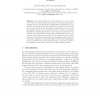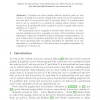1201 search results - page 1 / 241 » Linear Probing and Graphs |
111
Voted
ESA
2009
Springer
15 years 5 months ago
2009
Springer
The interval graph for a set of intervals on a line consists of one vertex for each interval, and an edge for each intersecting pair of intervals. A probe interval graph is a varia...
121
click to vote
INFOCOM
2009
IEEE
15 years 7 months ago
2009
IEEE
— The automatic detection of failures in IP paths is an essential step for operators to perform diagnosis or for overlays to adapt. We study a scenario where a set of monitors se...
WG
2007
Springer
15 years 6 months ago
2007
Springer
Cographs are those graphs without induced path on four vertices. A graph G is a probe cograph if its vertex set can be partitioned into two sets, N (non-probes) and P (probes) wher...
107
Voted
ALGORITHMICA
1998
15 years 15 hour ago
1998
Mallows and Riordan showed in 1968 that labeled trees with a small number of inversions are related to labeled graphs that are connected and sparse. Wright enumerated sparse connec...
101
click to vote
ALGORITHMICA
2007
15 years 13 days ago
2007
A tree t-spanner T in a graph G is a spanning tree of G such that the distance between every pair of vertices in T is at most t times their distance in G. The tree t-spanner proble...


